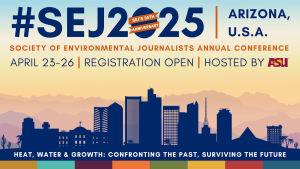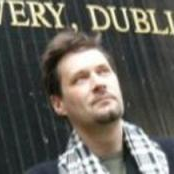Co-Chairs Welcome Letter
Welcome to Arizona! #SEJ2025
The Southwest is at the epicenter of climate change and the collision of renewable energy, water use and environmental justice issues.
Many people hear the word “Arizona” and envision a bleak, nearly lifeless landscape. Nothing could be further from the facts.
Arizona has seven major ecoregions and 52 lesser-scale ecoregions, according to the U.S. Geological Survey. From low-lying desert and alluvial floodplains to the famed Sky Islands, home to many endangered endemic species, Arizona also has the world’s largest stands of Ponderosa pine, most of the planet’s saguaro cactus, a major stand of Joshua trees and even three ski parks.
Nearly 30 percent of the state is tribal lands, with 22 federally recognized tribes, plus one non-recognized tribe and a small community of Kickapoo people who moved from their native Oklahoma to southern Arizona in the early 20th century. The Navajo Nation and the Hopi Tribe are still dealing with the long-term effects of uranium mining as well as obtaining a sustainable water supply. Other tribes are also engaged in land and water stewardship.
 Phoenix is a city of contrasts, where high rise buildings reflect heat and light on a downtown scene that in the summer is more like a hellscape. Water use is growing as water becomes scarcer. Yet, people continue to flock here. The U.S.’s hottest city is working to combat an ever-hotter climate – and it could be doing more.
Phoenix is a city of contrasts, where high rise buildings reflect heat and light on a downtown scene that in the summer is more like a hellscape. Water use is growing as water becomes scarcer. Yet, people continue to flock here. The U.S.’s hottest city is working to combat an ever-hotter climate – and it could be doing more.
Elsewhere, the clash rages on between those who want to bore into the earth for the metals to fuel a new energy economy and those who want to preserve sacred and cultural sites, waterways and wildlife habitats. One of our tours will take journalists to Ha’Kamwe Spring just southeast of Wikieup, where the Hualapai Tribe has been battling to prevent lithium mining from draining their sacred spring as well as other groundwater in the Big Sandy River watershed.
And Oak Flat continues to be ground zero for a struggle between Native religious rights and the protection of one of Arizona’s remaining undisturbed riparian zones and a mining company wishing to turn the area into a giant crater to obtain copper.
Arizona also shares a border and the vast Sonoran Desert with neighboring Mexico, creating both challenges and opportunities for species conservation and environmental management. Despite contentious U.S. politics laser-focused on the border and a fence slicing through critical habitat, the Arizona-Sonoran borderlands are also the site of long-standing and growing binational collaboration addressing environmental issues that impact life throughout the region.
Wildfires, drought, agriculture, groundwater depletion and an ever hotter, dryer future loom large in the Southwest.
Yet people continue to develop new ways to cope with a rapidly-changing climate, or to look to the past for time-honored solutions to recreate and maintain a sustainable Southwest. They’re returning to traditional, water-sparing food crops like tepary beans and agave. People are working to preserve medicinal and culturally important plants, as well as conserve important food sources like the Emory oak.
As our world continues to deal with the effects of climate change in the here and now, the work we do as environmental journalists has never been more important. And the issues facing Arizona resonate around the country and across the globe.
The 2025 SEJ Conference, with three local co-chairs, reflects the variety of professional avenues within our network. All deeply rooted in this region, each represents different aspects of our journalism community: investigative reporting and nonprofit newsrooms; cross-border reporting, public radio and journalism education; and a sizable environmental team with national reach and a speciality in Indigenous reporting. This conference not only brings value to each of those areas, but connects the journalists who span them.
The SEJ network provides a wealth of knowledge and support strategies for keeping environmental reporters engaged and energized to provide readers with the facts and the context they need to navigate rapid changes in a warming world.
Your co-chairs:



